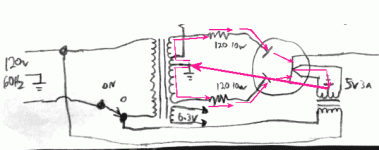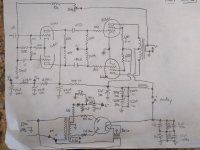Ok so long long long story on this one but where we are now is that its complete but something is wrong 😕. I've converted to a tube rectifier, modified the bias circuit, as well as pretty much reworking the pre-amp altogether, though I'm pretty sure the problem is in the power section.
So, when I power up (standby in disconnect) all filiments light up nice and every thing seems alright no smoking, horrible noises for a minute or so then my GZ34 rectifier starts arching and then the fuse blows. I did up the fuse rating after first stock 2amp fuse blew (to account for additional filiment trans for the GZ34) still arched and blew. I did this like 3 times and noticed that the rectifier only archs across one diode and the fuse doesn't start crackling til the rectifier archs....
I added a filter cap stage before the standby, as per all rectifier amps, rates at 33uf and 900 watts new sprauges. Also for the rectifier conversion I added 2 120ohm 10w current limiting resistors on the secondary to increase the transformer resistance as need by the rectifier.....I calculated their value and added alittle for safety following the valve wizards advice at the bottom of this page: The Valve Wizard maybe I screwed this up?? But I wonder if it may just be a bad rectifier, it is an old JJ I bought 10 years ago. Or if it might be possible that the power tubes have gone bad rolling around in a box for more than a decade and killed the rectifier & blowing the fuses??? Even with it in standby?? I dunno, all the old filter caps look good, tight, no leaking, they are 20years old.... Anyhow before I start spending money on tubes and caps and blowing those up I was hoping someone could look over my schematics and maybe pick up an 'awe ****' kinda thing that might be my problem or have some ideas of things to check to narrow it down. Thanks in advance!
Power Amp
Pre-Amp
So, when I power up (standby in disconnect) all filiments light up nice and every thing seems alright no smoking, horrible noises for a minute or so then my GZ34 rectifier starts arching and then the fuse blows. I did up the fuse rating after first stock 2amp fuse blew (to account for additional filiment trans for the GZ34) still arched and blew. I did this like 3 times and noticed that the rectifier only archs across one diode and the fuse doesn't start crackling til the rectifier archs....
I added a filter cap stage before the standby, as per all rectifier amps, rates at 33uf and 900 watts new sprauges. Also for the rectifier conversion I added 2 120ohm 10w current limiting resistors on the secondary to increase the transformer resistance as need by the rectifier.....I calculated their value and added alittle for safety following the valve wizards advice at the bottom of this page: The Valve Wizard maybe I screwed this up?? But I wonder if it may just be a bad rectifier, it is an old JJ I bought 10 years ago. Or if it might be possible that the power tubes have gone bad rolling around in a box for more than a decade and killed the rectifier & blowing the fuses??? Even with it in standby?? I dunno, all the old filter caps look good, tight, no leaking, they are 20years old.... Anyhow before I start spending money on tubes and caps and blowing those up I was hoping someone could look over my schematics and maybe pick up an 'awe ****' kinda thing that might be my problem or have some ideas of things to check to narrow it down. Thanks in advance!
Power Amp
An externally hosted image should be here but it was not working when we last tested it.
Pre-Amp
An externally hosted image should be here but it was not working when we last tested it.
Last edited:
The schematic shows a grounded center tap on the heater of the rectifier.
The heater is connected to the cathode, so to the HT.
Grounded HT = sparks
The heater is connected to the cathode, so to the HT.
Grounded HT = sparks
try attaching your images directly...
Like this.
Attachments
Yep. That's not going to work well at all.
Disconnect the secondary's CT of the 5v filament transformer as alluded to by Parafeed813
Disconnect the secondary's CT of the 5v filament transformer as alluded to by Parafeed813
Like this.
I tried to find how to do that but couldn't....oh ok now I see it way at the bottom of the post page not in the action buttons along the top of the dialog box....
Attachments
The schematic shows a grounded center tap on the heater of the rectifier.
The heater is connected to the cathode, so to the HT.
Grounded HT = sparks
Oh damn, you know thinking back years ago when I installed that heater trans, I remember not being to sure about the center tap, maybe I was figuring along the lines of the common sudo-CT used on filiment supplies..... Or that they wouldn't have added on if it wasn't necessary....idunno, will try this when I get be to the house, GZ34 is probably toast now... I was thinking of getting one of those yellow jacket SS rectifier plugins just to check everything before I drop another tube in there to blow...
Jbobxxxv,
Since you're working with a high voltage supply with potentially fatal voltages, one thing you might consider is building a piece of test equipment called a "Light Bulb Current Limiter" before you go any further.
Most of us who do any amount of amp work usually have one on the bench. It consists of a standard dual-outlet receptacle in an electrical box that also has a light socket and a 100 watt light bulb wired in series with the outlet.
The genius of it is this -- if you plug an amp that is working properly into it and turn the amp on, the amp will look like it is working normally (and the light bulb will glow dimly, if at all). In many cases, you can actually play it quietly, but it is guaranteed to go wacky if you give it any volume.
If the amp has any kind of current fault or short circuit, the amp won't power on properly and the light bulb will glow brightly (the bulb "starves" the amp for current if something is wrong and drops the voltage tremendously). The great thing is you usually don't burn anything up if you have a wiring fault. If you have a bad or shorted component, the amp can't get enough current through the light bulb to burn up anything else.
My latest averted-disaster was I replaced the output transistors in a guitar amp.........and the bulb glowed so brightly that I could read the newspaper with it. Powered it off, checked my wiring and discovered that I had swapped the collector and emitter wires on both power transistors. Wired it up correctly and the amp happily powered right up with nothing destroyed.
Here is a link to one of many examples:
http://www.geofex.com/Article_Folders/SPO_Test.htm
Dave
Since you're working with a high voltage supply with potentially fatal voltages, one thing you might consider is building a piece of test equipment called a "Light Bulb Current Limiter" before you go any further.
Most of us who do any amount of amp work usually have one on the bench. It consists of a standard dual-outlet receptacle in an electrical box that also has a light socket and a 100 watt light bulb wired in series with the outlet.
The genius of it is this -- if you plug an amp that is working properly into it and turn the amp on, the amp will look like it is working normally (and the light bulb will glow dimly, if at all). In many cases, you can actually play it quietly, but it is guaranteed to go wacky if you give it any volume.
If the amp has any kind of current fault or short circuit, the amp won't power on properly and the light bulb will glow brightly (the bulb "starves" the amp for current if something is wrong and drops the voltage tremendously). The great thing is you usually don't burn anything up if you have a wiring fault. If you have a bad or shorted component, the amp can't get enough current through the light bulb to burn up anything else.
My latest averted-disaster was I replaced the output transistors in a guitar amp.........and the bulb glowed so brightly that I could read the newspaper with it. Powered it off, checked my wiring and discovered that I had swapped the collector and emitter wires on both power transistors. Wired it up correctly and the amp happily powered right up with nothing destroyed.
Here is a link to one of many examples:
http://www.geofex.com/Article_Folders/SPO_Test.htm
Dave
Last edited:
Thanks for the input dlvoots, I'm familiar with the comon homemade curent limiting rig and their use, I think it was uncle Doug on YouTube were I first saw it years ago, and I did consider making one for this, but then it would just go in the trash. figured if something blows oh well. I've been dragging this amp around in a half done state for years. I guess I'm saying that I'm just a tourist and the thing has just been a boat anchor so I can't really hurt it in some sense.
In case someone is worried I'm some yahoo that'll kill themselves, I'm not. I've worked with high voltage professionally. This has been a one off project I started as a way to learn new (old) stuff.
In case someone is worried I'm some yahoo that'll kill themselves, I'm not. I've worked with high voltage professionally. This has been a one off project I started as a way to learn new (old) stuff.
Update: for any that are interested, after removing the rectifier C/T I cranked it up and got sound and no fuzes blowing but it was a loud uncontrollable squealing ocillating noise. I decided to build up a light bulb current limiter for further digging around....
I've now swapped the Output trans secondarys on the speaker jacks and brought it up on the current limiter with a 150w bulb. And now it works! I get actual guitar noises out if it but it has Way to much gain it seams, as I can't crack the volume above 1.5 without sreetches and feedback. It's also to boomy/bassy altogether, which I was afraid of to begin with. So, I'll be looking at toning back the gain throughout and maybe swaping some of the coupling caps to reign in the bass response. Anyhow, thanks for all the help and advice! Things are going in the right direction
I've now swapped the Output trans secondarys on the speaker jacks and brought it up on the current limiter with a 150w bulb. And now it works! I get actual guitar noises out if it but it has Way to much gain it seams, as I can't crack the volume above 1.5 without sreetches and feedback. It's also to boomy/bassy altogether, which I was afraid of to begin with. So, I'll be looking at toning back the gain throughout and maybe swaping some of the coupling caps to reign in the bass response. Anyhow, thanks for all the help and advice! Things are going in the right direction
- Status
- Not open for further replies.
- Home
- Live Sound
- Instruments and Amps
- Customized silverface bassman, Help!!?



